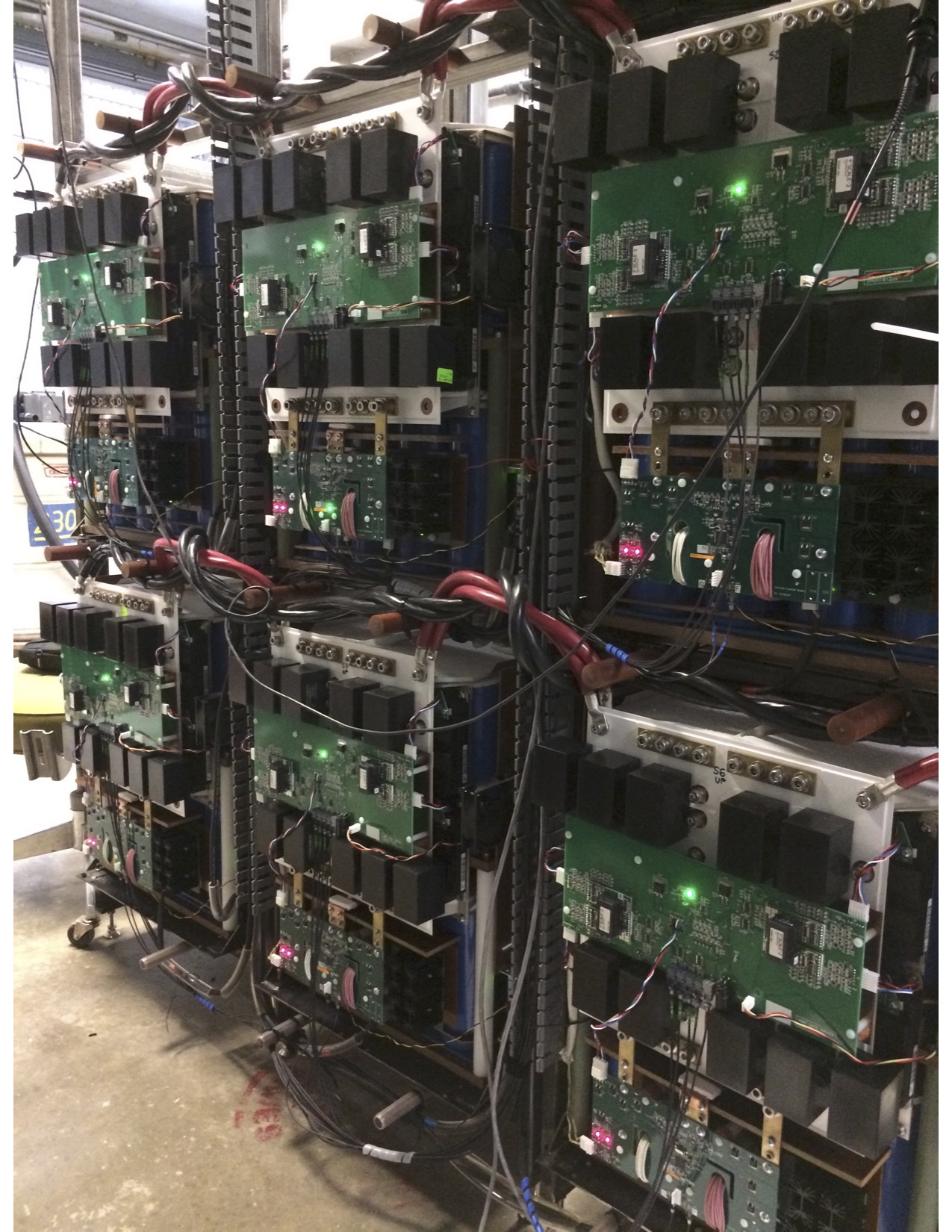
A UW-Madison Physics Department research team led by Dr. Brett Chapman was awarded a two-year Major Research Instrumentation grant from the National Science Foundation (NSF) for construction of programmable power supply (PPS) modules for experimental use on the Big Red Ball (BRB) and the Madison Symmetric Torus (MST) at WiPPL. The PPS modules are digitally programmable and feedback controlled, based on a prototype, pictured above, already in use on MST to drive toroidal plasma current, which generates a poloidal magnetic field confining the high-temperature plasma. The modules, six of which are shown in the picture, can be used individually, or they can be used in groups as large as desired, providing a wide range of maximum current. The modules provide for substantially more flexible and sophisticated plasma experiments at WiPPL. Some experiments will be accomplished much more readily and quickly with the modules, but the modules will also enable other experiments that would otherwise range from difficult to impossible. This capability is illustrated with the MST plasma current signal plotted below, with 100,000 amperes of MST plasma current being modulated with an embedded “UW” waveform. On BRB, the modules will enable an easily scannable toroidal guide field for ongoing magnetic reconnection studies, as well as future experiments on the formation of spherical tokamaks for adiabatic compression and ion heating studies, for example. On MST, they will help enhance the capabilities of the power supplies now in use to provide both poloidal and toroidal magnetic fields, enabling increased operational performance for physics studies of reversed-field pinch and tokamak plasmas. This new power supply capability funded by the NSF will substantially enhance and broaden the plasma science research that can be carried out at WiPPL.
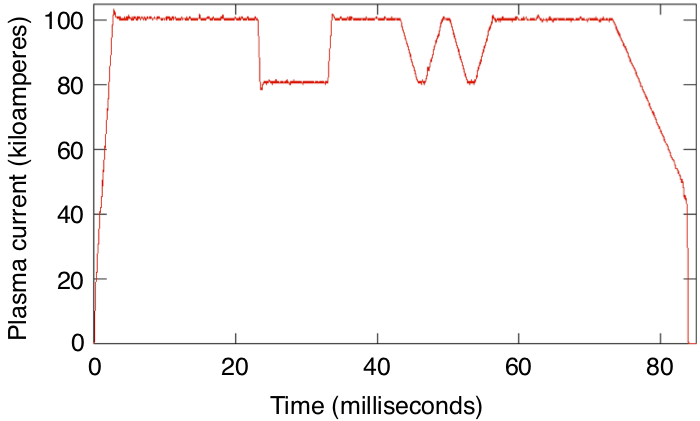
Year: 2018
Princeton Users See First light from Multi-Energy Soft-X-ray camera
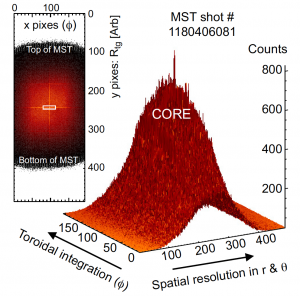
A collaboration between Dr. Luis? Delgado-Aparicio (Princeton Plasma Physics Laboratory), Dr. Lisa Reusch, and Dr. Daniel Den Hartog (UW-Madison) has successfully installed and operated a new soft-x-ray camera based on the Pilatus3 detector made by DECTRIS Laboratories in Switzerland. The detector has the novel features of using a thick silicon layer bonded to a 100k pixel CMOS detector and per-pixel control of the pulse height comparator providing sharp energy thresholding. A pinhole in front of the detector allows it to be used as an x-ray camera with extremely high spatial resolution.? The combination of a large number of pixels with individual energy settings allows the camera to be operated with both high spatial and spectral? resolution enabling it to function as a high resolution Multi-Energy Soft-X-ray (ME-SXR) detector.
This ability to simultaneously set multiple energy thresholds enables ? simultaneous measurement of both continuum and line emission features in the 2-8 keV range where highly-charged ions contribte to the emission spectrum. The camera was installed in? the spring of 2018, and the first data collected with the system is shown in Figure 10. It shows the number of counts generated from x-ray photons with energy greater than? 4 keV. These x-rays were created by thermal electrons in a 500 kA MST discharge.
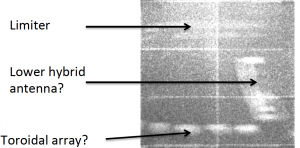
To get a sense of the spatial resolution o? f the camera, images were taken when fast electrons from the plasma were striking objects on the wall of the vessel, lighting them up with x-ray emission. In the image on the left, different structures are apparent in the image.
This camera will be used to measure temperature and density, structures in helical plasmas, detect fast electrons generated by fast magnetic reconnection events, and quantify resistive dissipation in? MST plasmas.
Compressible MHD turbulence studied in high-beta plasmas
In March, the Big Red Ball at WiPPL was operated for an investigation of compressible MHD turbulence proposed by a collaboration of Swarthmore College professor Mike Brown, Swarthmore undergraduate student Emma Suen-Lewis, and Bryn Mawr College professor David Schaffner. They proposed to measure the correlations between density and magnetic field fluctuations to distinguish between fast and slow waves in turbulent, high-beta magnetized plasmas. Suen-Lewis and Schaffner visited WiPPL to oversee the initial plasma run days. UW-Madison graduate students Doug Endrizzi and Ethan Peterson operated an array of biased plasma guns with a background axial magnetic field in order to create the experimental flux-rope plasmas, an example of which is seen in the video below. Endrizzi also designed, built, and operated a novel combination Langmuir and magnetic fluctuation probe to carry out the correlation measurements. Suen-Lewis is analyzing the experimental data for an undergraduate thesis at Swarthmore.
Italian visiting scientists commission fusion neutron detector
A group of three scientists from Italy made use of the MST device during a two week stay this spring. ? Dr. Matteo Zuin (Consorzio RFX), Dr. Luigi Cordaro (University of Padua), and Dr. Cristiano Fontana (Istituto Nazionale di Fisica Nucleare Sezione- National Institute of Nuclear Physics) used MST plasmas with a substantial fusion neutron flux to commission a set of neutron and gamma discriminating detectors.
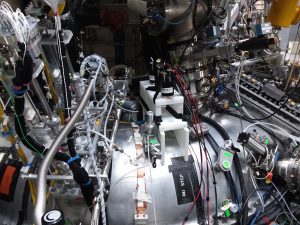 The diagnostic boasts of a very fast time response with on-the-fly pulse shape discrimination to distinguish between neutron and gamma counts on the scintillator. ? This cross-discipline collaboration was especially productive in adapting nuclear physics? counting techniques to a plasma physics short pulse, high flux discharge. Previous pulse counting techniques on plasma physics experiments record the detector output for the full duration of the discharge, then analyze the pulses? between shots. ? The counting specialist, with a nuclear physics background, is accustomed to a detector that free-runs for long periods of time, ? processing the data and registering counts as they come in??” ? a technique well suited for low count rates. ? In discharges with neutral beam injection on MST,? each of the five detectors was routinely subjected to count rates exceeding 50kHz, which challenged the system’s ability to keep up.
The diagnostic boasts of a very fast time response with on-the-fly pulse shape discrimination to distinguish between neutron and gamma counts on the scintillator. ? This cross-discipline collaboration was especially productive in adapting nuclear physics? counting techniques to a plasma physics short pulse, high flux discharge. Previous pulse counting techniques on plasma physics experiments record the detector output for the full duration of the discharge, then analyze the pulses? between shots. ? The counting specialist, with a nuclear physics background, is accustomed to a detector that free-runs for long periods of time, ? processing the data and registering counts as they come in??” ? a technique well suited for low count rates. ? In discharges with neutral beam injection on MST,? each of the five detectors was routinely subjected to count rates exceeding 50kHz, which challenged the system’s ability to keep up.
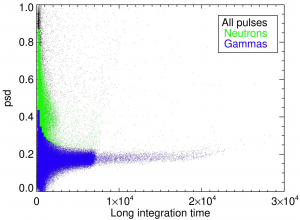
In just under a week with the full crew on site, the typical challenges of experimental installations were all solved. and Dr. Fontana? stayed on another week to collect data in several different plasma conditions, including neutral-beam heated discharges with varying deuterium concentration, as well as discharges with a natural fast ion population from both strong ‘sawtooth’ reconnection events and from quiescent, high-confinement plasmas where such events are suppressed. ? It was a very successful visit overall, with the diagnostic operating robustly through all conditions. ? One challenge remains: ? with the ability to measure neutron flux on five independent detectors, a suitable collimation system will allow instantaneous measurement of a fast ion density profile. ? This addition will help answer questions on the details of the reconnection-based ion heating, the dynamics of fast ions during the transition to the RFP’s single helicity state, and the effects of fast ion driven instabilities in the Reversed Field Pinch.